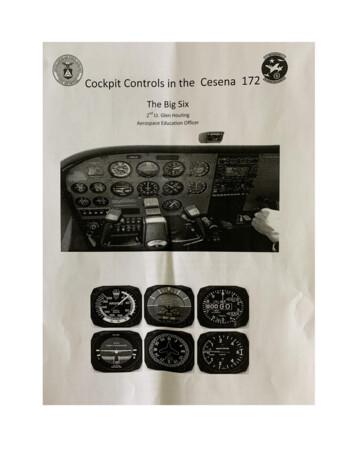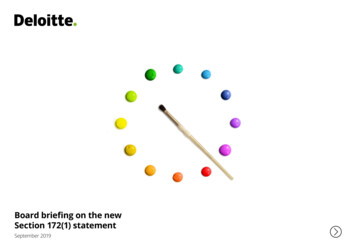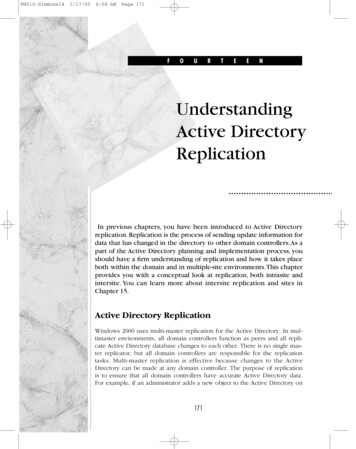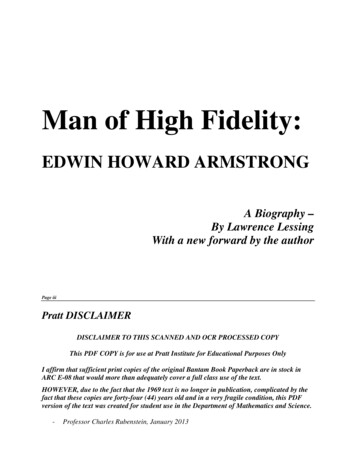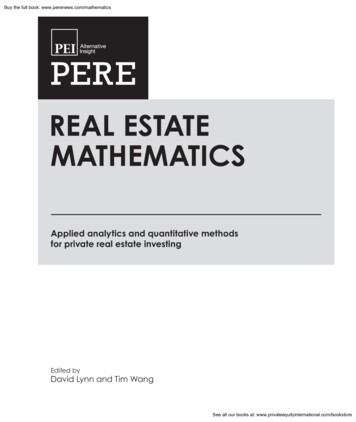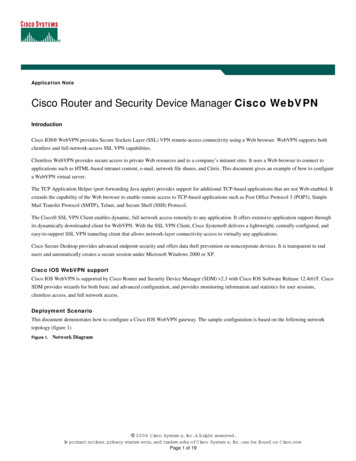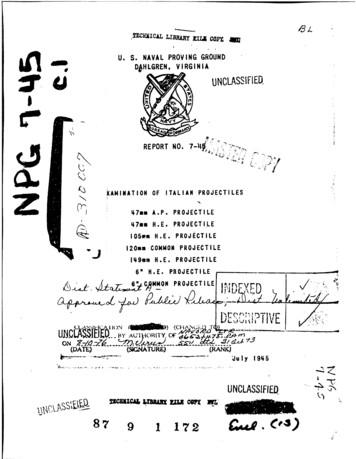
Transcription
coP)-2C2CHXIC, LIEWyU. S. NAVAL PROVING GROUNDDkHLGREN, VIRGINIALin I14JUNCLASSI1FIED.REPORT NO.kAMINATION7 -.4ITALIANOFH.E.PROJECTILE105mm H.E.PROJECTILEI149mm H.E.6a( *PROJECTILESPROJECTILE12080 COMMONPROJECTILE)(CHAN .iY'VT'OF '04RIZ (SI.,NATURE)(DATE)%KI147mm A.P.47nmIIONr: Jp./.(RANK)'July 19,45UNCLASSIFIED CA WamJa Em8791 172m.
U. S.NAVAL PROViNG GROUNDDAHLGREN.VIRGINIAJuly 19' 5REPORT NO.7-45EXAMINATION OF ITALIAN PROJECTILES47mm A.P,PROJECTILE47mm H.E.PROJECTILE105mm H.E. PROJECTILE120mm COMMON PROJECTILE149mm H.E.6" H.E.PROJECTILEPROJECTILE6" COMMON PROJECTILE ., APP ROV Eý -- .-K. N. MCLARENCAPTAIN, U. S. N.ACTING COMMANDING OFFICERPreface, Page i
UNCLASSIFIEDPREFACEAUTHORI ZATIONinvestigationswereEF 74(Re3) dated 23 Decemberissued in BuOrd ltr.EF 74(Re3) dated 26 February 1945.and BuOrd ltr.1944SpecificfordirectivestheseOBJECTTo make a completeexaminationof thephysical,following47mm A.P.47mm H.E,chemicalItalianand metallurgicalprojectiles.ProjectileProjectile105mm H.E. Projectile120mm Common Projectile149mm H.E.6"H.E.ProjectileProjectile6" Common ProjectilePreface Page ii
INDEXuNCLASSIFIEDSECTIONIVEXAMINATION OF ONE ITALIANEXAMINATION OF ONE ITALIANEXAMINATION OF ONE ITALIANEXAMINATION OF ONE ITALIANVEXAMINATIONIIIIIIVIVII47mm AP. PROJECTILE47mm H.B. PROJECTILE105mm H.E. PROJECTILE120mm COMMON PROJECTILE149mm H.E. PROJECTILEOF ONE ITALIANPROJECTILEEXAMINATION OF ONE ITALIAN 6" HE,ITALIAN 6wEXAMINATION AND BALLISTIC TESTS OFCOMMON PROJECT ILESfrATLAS S!FI EPrefacePageiii
UNCLASSIFIED.IEXAMINATION OF ONE ITALIAN 47mm.A.P, PROJECTILECEE NO.3662SUMMARYThis projectile was made from nickel, chromium,was forged and machined,silicon steel.Itthen heated uniformly and quenched and drawn.The base was drawn in a separate operation to a low hardness.ness survey of the enti-re projectile was made.The chemical analyses and microstructurecomponents are given.A hard-of all the projectileUINCLASSIFIUESection1, Page i
UNcUASSIrECONTENTSPageI.INTRODUCTION . .I.EXAMINATIONPhysical, Chemical,.MetallurgicalDISCUSSION .Hi.1.I.2LIST OF FIGURESFig.Fig.Fig.OppositePage123NPG Photo No. 2270 (APL) As Receivedand Disassembled View .1NPG Photo No. 2548 (APL)Projectile and Case .1Markings on.NPG Photo No.Distribution2546 (APL) Hardnessand Macro-section .2Fig.4NPG Photo No.2649 (APL)Microstructures.2Fig.5NPG Photo No.2650 (APL)Microstructures.2Section I,Page ii
Figure INi½L 1hoLo No.2270(APL)As received and disassembled view of Italianround.cE3 No. 3662.15 May 191,5,NCLASS IFMr t\PY"47mm A.P.N ,
FigJureMARKINGS2ON ITALIANPROJECTILE4Tmm APAND CASEGEE 3662Orange.StenciledT-PDOG. 0,DIREZ,22-All1941247132NPC. PhotoMov 15,1945No iv,75x xllOxl40 Dr. 1734069008-'941'D'ARTIGL,-PIACENZANOVEMBRE 9'41
UNCLASSF-, INTRODUCTIONI.One Italian 47nfn A.P. round was received at the Naval Proving GroundThefor complete physical, chemical and metallurgical examination.with theacccrdancea report of this investigation infollowing isdirectives.EXAMINATIONII.PHYSICALThe complete round, as received and disassembled isisThe projectileshown inprovided with a windshield which isfound on the round are reproducedmarkings show that the case was manufactured inincrimped to thefuze and tracer.nose and with a base plug carrying a base detonatingThe markingsFigure 2.Colors used toloading are also shown inthe projectile and itsThese1941 but give no indi-cation as to the date of manufacture of the projectile.identifyFigure 1.Figure 2.CHEMICALChemical analysesfollowing table.components areof the projectilegiven intheSteel analyses are spectrochemical excepting carbon,phosphorus and sulphur which have been obtained by standard wet chemicalmethods.CMnSPSiNiCrMoCuAl rBody.50.53.027.0221.23.62.80.02Base Plug.36.62.015.014.29 .08NTr .005CuZnSnFeP.035.035.120.024Band99.78Tr TraceNTr No TraceThe windshield has been fabricatedfrom a low carbon rimmed steelof the type commonly used for the manufacture of thin sheetfor deep drawing.A nickel,chromium,silicon steel has been used forthe body of the projectileand the base plug ismedium carbon steel similarto SAE 1035.but isto be usedmanufacturedfrom aThe rotating band is copperrather impure as compared to American standards for this material.,I-L VSection 1. Page I
Figur , oniumMAGROSECTIONAP PROJECTILE47mmOF ITALIANHardnessAND(50Kg.)PersulphateCEE 36628 3 9 475026236234 54659554397253 25836ý4273258 2655258434 '05 25 43 25472524653526245632022532502154I1f1J 4111Iu25273265ScaleNFGPhotoNo.2546(APL)May 15,1945,IIJLASSIFtIbI t
Figure 4S-0FMICROSTRUCTURESmm? A.P PROJECTILEITALIAN"PROJECTILE NOSE"w-.,S.Martensitewith Bafnite Needles. : .- 610VPNS.-Hardness,Magnification - 10001.EtchPicral Nital. M489-" - , PRO/ICTILE BASEe"""Magnification jHardness260 - 4o. 1920NPG PhotoJune5
SFigure 5MICROSTRUCTURES OFITALIAN-47mmAl PROJECTILEAAWINDSHIELDHardness-Ferrite79 RbMagnificationEtch -Nital -250X12492AwBASE PLUG40ýPearlite anderriteHardness - 85 RbMagnificationEtch - Picral-250X'OaktitNPG Phioto Yo. 2650 (Al"L)15 June 1945 S!r,,,:SSIJ I
METALLUiGICAL'fhe projectile body was split longitudinally with an abrasive cut-offwheel and a hardness survey made of the entire cross-section.Figure 3shows the hardness distribution and macro-etch section of the body.Amaximum hardness of approximately 630 VPN (56Rc) has been obtained onthe nose of the projectile.The hardness drops off slowly from the noseto a point abouta quarter of an inch above the band score where itdrops off rapidly to approximately 260 VPN (25Rc)which hardness ismaintained throughout the base.The flow lines shown in the macro-etchsection indicate that the projectile was forged and machined.The microstructureinFigure 4.of the nose and base of the projectile are shownBoth structures were produced by a normal quench andtemper operation,the nose consisting of martensite and bainite and thebase, tempered martensite.The microstructures of the other componentsof the projectile are shown in Figure 5. The windshield is seen toconsist of ferrite with perhaps a slight trace of pearlite, while thebase plug has a normalized structure of pearlite and ferrite.Thehardness of these two components was found to be as follows:III.Windshield--Base Plug---79 Rb85 RbDISCUSSIONThe maximum nose hardness of this 47mm projectile is somewhat lowerthan the nose hardness of American projectiles of this caliber.TheAmerican 37mm and 40mm AP projectiles generally have a nose hardnessof from 700 to 750 VPN (60VPN (56Rc)to 62 Rc),as compared to approximately 630for the subject projectile.An examination of the photomicrographs and etch section of thisprojectile indicate that it was probably heat treated in the followingmanner,(a)Heated uniformly(b)Drawn at a temperatureto above itscriticaltemperature andquenchedmately 630 VPN (56Rc)(c)Base drawn into produce a hardness of approxi-lead at a temperaturebetween1100 and1200 FSect.I,Page 2
IIEXAMINATION OF ONE ITALIAN 47mmH.E. PROJECTILECEE NO.3662SUMMARYThe projectile body was machined from a sulphur bearing plain carbonsteel.It was given a single normalizing heat treatment, and has auniform hardness of approximately 92 RB.The chemical composition and microstructure of the projectile aregiven.Sect.II.Page i
UNCLASSIFIEDCONTENTS.I.INTRODUCTION .II.EXAMINATION - Physical,III.DISCUSSION .PageIChemical, Metallurical .I.2.LIST OF FIGURESOppositePageFig.Fig.12NPG Photo No. 1850 (APL)As Received and Disassembled View.NPG Photo No. 2443 (APL)Markingson Projectile and Case .Fig.3NPG Photo No.2594 (APL)Deep Etched Section.1Fig.4NPG Photo No.2651Microstructure.1(APL).UJN CLASS IF1ESection II,Pageii
FigureINI G Photo No. 1350 (APL).As receiv.-d and disassembled view of' Italian 47mm H.E.r:hund.CE?Ap,3662.!-ay 1943l- l-'9--M
MARKINGS47mmHEITALIANONPROJECTILECEE .'ý6O2 Ulnpainted Cr1 ngeSI-ci-d2 340G ryTRETQ,, 47Gr enn SdiCoracaMotDIREZ-- All Markinsstilrped19414NONPGPhotoMay15, !9452443(APL)ONE2r. ,. tStencl',nmg47/32P CPov4G3405 0 1/41940ARTIGLIERIABOLOGNA 1940
Fig ure 3NPG PHOTO NO. 2594 (APL)Deep etched section of Italian 47mm H.E.MCEE No. 3662.15 May 1945projectile.
NPC Pýhoto No.2651(APL)941MNUNCLASSIFIEDFigure 4MIC'ROS.ThUCTMJE OF TI-El BODY OFITLIANT 47mm HE-; PRCJECTILEFine 7P.earlite and FerriteHardnessEtch--92 PRbPicral15CAI'agnif ication. 250):7493J une1945
I;INTRODUCTIONOne Italian 47mm II.E. round was received at the Naval Proving Groundfor complete physical, chemical, and metallurgical examination.Thefollowing is a report of this investigation in accordance with thedirectives.II.EXAMINATIONPHYSICALThe complete round, as received and disassembled,isshown in Figure1-. The projectile extends into the case nearly half its length, and isfitted with a narrow rotating band near its center.A contact type nosefuze is provided.The markings found on the round are 3hown in Figure 2and indicate that the care was manufactured in 1941, but give no indication as to the date of manufacture of the projectile.The colors usedto identify the projectile and its loading are also given in Figure 2.CHEMICALA chemical analysis of the projectile body and rotating band is givenin the table below.Steel analyses a:te spectrochemical with the exception of carbon, phosphorus, and sulphur which have been obtained bystandard wet chemical methods.BodyCMnP.56.82.022S.080SiNi.18 .08Cu7nSnFePBand99.87NoneNone.091.043NTr No traceCrMoNTrNTrCuAl.11NTrThe projectile has been machined from a plain carbon steel with ananalysis similar to SAE 1055.Attention is invited to the high sulphurcontent of this steel probably added for increased machinability.The rotating band iscopper.METALLURGICALThe projectile body was split longitudinally and deep etched toreveal the flow lines. Figure 3 shows the etched section and indicatesthat the projectile was machined from bar stock.A uniform. hardness ofapproximately 92 Rb was obtained along the surface of the body.Themicrostructure of the projectile body is shown in Figure 4.It consistsof fine pearlite and ferrite and has a relatively large number of nonmetallic inclusions.LSect.U, Pa'g I
DISCUSSIONThe subject projectilebody was manufacturedfrom a plain carbongiven a single heatwas machined from bar stock and wasair cool from above the criticaltreatment probably consisting of ansteel.Ittemperature.J N,G! 'sSect. II,Page 2
UNCLASSIFIEDIIIEXAMINATION OF ONE ITALIAN105mm H.E. PROJECTILECEE NO. 3651SUMMARYIt was madeforging.This projectile was produced by piercing andTheto SAE x 1345.from a high manganese, free machining steel similarare given.chemical analysis of the projectile and its componentsSect.III.Page i
UNCLASSIFIEDCONTENTSPageI.INTRODUCTION .II.EXAMINATION-III.DISCUSSION .Physical,.Chemical, Metallurgical .1.LIST OF FIGURES12Oppos i tePageFig.1NPG Photo No.AsFig.2Received1404 (APL)and DisassembledViewNPG Photo No. 2550 (APL) Markingson Projectile .1.1Fig.3NPG Photo No.2555(APL)Deep Etched Section1Fig.4NPG Photo No.2652(APL)Microstructures2.Section 11.Page ii
NPG Photo No.1404 (APL)105mmAs received and disassembled view of ItalianH. E. projectile.CEE No. 3651.15 May 1945U, . 1ED,I.c'"i-e - --m re,!.
MARKINGS105mmONITALIANHE PROJECTILECEE3651OrangeIndistinctStencilingMIGL 98BrownKg,16.050AMATOLO 80/20R.B. -X105/78GreenBrownNPG PhotoNo 2550 APL'
2555 (AIL)NPG PIOTO NO.Deep etched section of italianCEE No. 3651.,-0015 loay 1945105mrm H.E.projectile.m,"-
UNCLASSIFIEDINTRODUCTIONI.One Italian 105mm H.E, projectile was received at the Naval ProvingGround for complete physical, chemical and metallurgical examination.The following is a report of this investigation in accordance with thedirectives.EXAMINATICNII.'PHYSICALFigure I shows the projectile as received and disassembled.plug isprovided with a threaded hole inA nosethe end for a detonating fuze.The projectile was received with a shipping plug screwed into the fuzehole.The markings found on the projectile and itsidentifying coloring are shown inthe drawing of Figure 2.Thereisno opening inbase of the projectile and only a very narrow rotating band istheprovided.CHEMICALA chemical analysis ofgiven incarbon,the table below.the projectile body and itscomponentsisSteel analyses are spectrochemical exceptingphosphorus and sulphur which have been obtained by standard wetchemical d99.86NTrNo TraceSSiNiCrMoCu.074,20 .08NTrNTr,18.049.20,16 .08 01.14oZnSnFeP.024.0470049.019The nose plug was manufacturedto SAE 1030 whilethe body offrom a plain carbon steel correspondingthe projectilewas mademachining high manganese steel similar to SAE X 1345.isfrom a freeThe rotating bandcopper.METKT.ALURGICALThe projectile body was sectioned longitudinally with an abrasivecut-off wheel and deep etched to reveal the flow lines.The deep etchedsection is shown in Figure 3.The distribution and direction of theflow lines indicate that the projectile was upset forged and pierced toSect.III,Page I
NPGPUIP, . 18%51 2)As recel val and di3sass embledP- v, ew of'I iCom o1, Tp20je,,tUlie 2No. 3437.15 .ay 1V45iŽ Uf WL' f-TjkEu
,2:MV,')NPQOJEGTIL[q ?1'ARUnpaflted2''A926LRL-C-*hitL 3 mO49911.930N PGMat, !5.Ph oto945No 2 442lAPLiAll Mofk ngs\
DISTRIBUTIONHARDNESS120mmOF ITALIANHardne s4'4429!69An m I456-5.549'-21'NtmI -[E ch-t.6359 54SI345543550-NPGPhotoMay 15,1945No.2551IAPL)MACROSECTIONANDPROJECTILECOMMON k-2 IISIn'I,Porrt 5LKmid-IP
Fi ,urew 4MTCROSTRUCrJRBS OFTILIANT105mm HE PIROJ3OCTILEBODY Pearlite andFerriteJ jorW Hardnessjo.99 Rbly'agnification20EtchaPicral - 250X-9WNOSE PLUGtPearlite andHardnessRbY 'WMagnifticationEtcrh-78-250XGL-PicralNPG. Photo No. 2652 (AýPL)15 June 1945 - . - -ra
UNCLASSIFIEDIvEXAMINATION OF ONE ITALIAN120mm COMMON PROJECTILECEE NO. 3437SUMMARYThis projectile was manufactured from a 0.47% carbon nickel-chromesteel bya forging operation. It was uniformly hardened and then basedrawn.The complete hardness pattern is given and the chemical composition of all its components was determined.Sect.IV, Page i
UNCLASSIFIEDCONTENTSPageI.INTRODUCTION .II.EXAMINATION-III.DISCUSSION .Physical, Chemical,1Metallurgical1.2LIST OF FIGURESOppositePageFig.Fig.Fig.123NPG Photo No. 1852 (APL)As Received and Disassembled View .1NPG Photo No. 2442 (APL) Markings onProjectile .1NPG Photo No. 2551 (APL) HardnessDistribution .1.Fig.4NPG Photo No.2444 (APL)Base PlugFig.5NPG Photo No.2653(APL)Microstructures.2Fig.6NPG Photo ection IV,Pageii
UNCLASSIFIEDform the cavity.The nose was shaped by forging and then finishmachined.A hardness of approximately 99 Rb was obtained onthe surfaceof the projectile body.In Figure 4 is shown the microstructure of thenose plug and body, both consist of icrrite and pearlite,the amount ofpearlite present being in proportion to the carboncontent of the steel.The nose plug had a uniform hardness of 78 Rb.IIIDISCUSSIONA high manganese,free machining,steel has been used in the manufacture of this projectile.It has been manufactured by forging andpiercing and has not received any special heattreatment.The microstructure indicatcs tha't it was normalized byheating to above thecriticaltemperature and cooling in air.Thie microstructure, heattreatment and hardness are similar to U.S. Navyprojectiles of thistype and size.Sect.TIX,rage. 2
UNCLASSIFIEDINTRODCTIONSOne Italian l20mM Common' projectile was received at the Naval ProvingGround for complete physical, chemical and metallurgical examination.The following is a report of this investigation in accordance with thedirectives.II.EXAMINATIONPHYSICALFigure 1 shows the projectile as received and disassembled.It isprovided with a windshield crimped to the ogive, a base plug and basedetonating fuze.Two rotating bands are used.The markings found onthe projectile and itsidentifying colors are given inFigure2.CHEMICALA chemicalgiven inanalysis of the projectile body and itsthe table below.components isSteel analyses are spectrochemical exceptingcarbon, phosphorus and sulphur which have been obtained by standard wetCMnWindshield.06.38Body.45Base .011NiCrMoCuNTr .08NTrNTr.18.014.78.55.81NTr.18.024.25 .08NTrNTrNTrFe.082P.106No TraceThe windshield of this projectile has been manufactured from a lowcarbon rimmed steel similar to that used for thin sheet to be processedby deep drawing.The projectile body ismade from a fairly high carbonnickel-chromeSAE 1050.steel and the base plug is plain carbon steel similar toThe rotating bands are copper.METALLURGICALThe projectile body was sectioned longitudinally with an abrasive cutoff wheel and itshardness distribution determined over theentirecross section Figure 3 shows the results of the hardness survey togethe1 with the etched section of the splitprojectile.A maximumhardness of approximately 600 VPN (55Rc) has been obtained onS. iEDSect.IV.,, Page I
2 4.24 (4.1NPC ?:iQTýD NO0Bottom, view and deep etc iedItalian i2Ormrn Commrori arojectLie15 Fay 1945fcet b:.7LEJ.3460'U"""'S" IEL
Uj;L S iF!Figure 5baICRO3TRUCTURES OFITALIAN 12Onmm CObNON 'O JECTILESPROJECTILE NOSE Yartensitewith Baint NeedlesHardness - 600 VPNMagnification - 100OXEtch -PicralNita!Mi. 95A",Aci,35 4A MartnsfioteoEtchA, 0O-Picral*m496 INTPG Photo No., 2653 (APL)JS I"Li
Figure 6MICROSTRUCTURES OFITALIAN 120mm COWONFROJECTILESpherodizedBASE PLUGYea rilte Hardness. ' '*" -92 Rb"MagnificationEtch - Picral-500X.M4979""r'/'k", - / 'p'Etchi, )----- Nital LPhoto No.NPG', /andHardness - 68 Rb 250XMagnification--N ',S.FerriteS1,WINDSHIELDTraces or Pearlite ,15, 265June 194 5(A)
UN LA 5ýTID the nose of the projectile.'loseThe hardnes!drops off uniformlyto the middle of the body at which point itVPN (36Rc).Flow lines infrom thelevels off at about 350the etch section indicate that the projectilewas produced by a forging operation.In Figure 4 isshown a bottom viewand deep etched section of the base plug, which also has been producedby forging.The cap seen covering the fuze hole has been machined frombaf stock as indicated by the straight flow lines running through it.The base plug had a uniform hardness of 92 Rb.Photomicrog'rhphs 'fthe projectile body are given inFigure 5.Boththe nose and base are quenched and tempered structures consisting ofcar'bides and tempered martensite.The microstr'icture of the base plugand wind-shield are shown in Figure 6. The base plug has a structureconsisting of spheroidizedferriteIIIpearlite and the windshikldislargelywith traces of pearlite.DISCUSSIONThis projectile has been forgedchrome steel.from a fairly high carbon nickel-A maximum hardness of approximately 600 VPN (55Rc)hasbeen obtained on the nose and the base has a uniform hardness of approximately 350 VPN (36Rc),hardness ispracticallyItisinteresting to note thatthe same as that of the US.projectile Mk. 46 but the base is somewhat harder.a base hardnescof between280 and 300 VPN (27.5From the photomicrographsand etch sectionthe noseNavy 5"commonThe Mk., 46 hasto 30Rc)-itappearsthat thisprojectile has been heat treatedto a uniform hardness of 600 VPN andthen base drawn,that itItpenetrative qualitiesisprobablewould havefairly good platefor the size of cavity used.Sect.IV,Page 2
UNCLASSIFIEDVEXAMINATION OF ONE ITALIAN 149mm H.E.CEE NO. 3648PROJECTILESUMMARYMetallurgical date and chemical analyses of the principal componentsof this projectile are presented together with the probable method ofmanufacture of the body and nose piece.The nature of the cavity indicates that this projectile is a chemicaltype.Sect. V, Page i
UNCLASSIFIEDCONTENTSPageI.INTRODUCTION .II.EXAMINATIONIII.DISCUSSION .-Physical,.1.Metallurgical, Chemical.1.2LIST OF FIGURESOppositePageFig.1NPG Photo No. 2793 (APL). .As Received and DisassembledFig.2NPG Photo No.2549 (APL)Drawing .Fig.3NPG Photo No.2596 (APL)Macro Etch Section.Fig.4NPG Photo No.2666Photomicrographs.(APL)1.1.2UFLr ASS IF!EDSectionV,Pajeii
N-G6'c'ýO No . 2793(A-PL).-.s receivýTed and disassembled view-ES.projectile,GEE No. 3648.15 945May-44a.- Itallrm-----11,9
E2ONMARKINGSHE149 mm*ITALIANPROJECTILEZEE 3648StnciledZdGreyteiIeSt en ci ed149/13WhiteNPG Photo No. 2549 (APL)Moy 15, ;945UNCLASSIH "
1d,3rL3NPG Photo No. 2596 (AFL).Deep etched section off Italiian 149mm H.E. projectile.CEE No. 3648.15 MAY 1945AlW E
UNCLASSIFIEDI.INTRODUCTIONOne JIt4jian high explosive 149mm projectile wvs examined in accordance wit'hi the directive.A report of the examination followe.II.EXAMINATIONPHYSICALFigure 1 showsprojectilethe projectile asreceived and disassembled.body has a large cavity which isdivided about midway by atrpnsverse threaded steel disk having 4 vent holes.suggests that the projectile carried a dual loading,as a burster and the rear charge as a smoke,TheThis constructionthe forward chargeincendiary,or gas filling.The body isisthreaded at the forward end to take a large nose piece whichitself threaded to provide for a nose fuze.A single narrow rotating band was attached inthe usual way.Figure2 shows the details of painting and marking.CHEMICAL ANALYSISThe chemical analyses of the important components are given below.Steel analyses are spectrochemical, except for the elements carbonphosphorus,and sulfur which were obtained by the usual wet chemicalmethods.CMnPSSiBody.73.94.034.074.08.13 .08NTr.18Nose.48.59.088.053.17NTrNT rNTr.08ZnFeCuBand99.91Sn.030.032NiCrMoCu.017The body is made of a steel similar to SAE 1075 with high sulfur content, and the nose is made of a steel similar to SAE 1045 with highphosphorus content.The copper of the rotating band is of high purity.The etch pattern of the nose section and of the body are shown in Figure3.Flow lines indicate that the body was pierced and the nose sectionforged.Both body and the nose section were uniform inNose Hardness94 Rockwell "BIBody Hardness98 Rockwellhardness.'B"tAS ST, PEaeD'Section V. Page I
Figure 4MICROSTRUCTURES OFITALIAN 1491m HE PROEECTILEBODYPearliteHardness - 98 RbMagnification250X"Etch - PicralNOSE SECTIONand Ferrite PearliteHardness - 94 RbMagnification - 250XEtch - PicralMl'501NPG Photo No.2666 (APL)15 June 1945lICD
UNCLASSIFIEDBothThe microstructure of the nose and body are shown in Figure 4,nose and body are normalized structures, the microstructure of the bodyconsisting of pearlite, and that of the nose consitiiigniof peasrJite andferrite.The probable steps inthe manufacture, of this projectile are This projectile was probably satisfactory for its intended purpose.TheThe prime considerati3n in its heat treatment was machinability.exact nature of the loading is unknown, but it was probably of thechemicaltype,smoke,incendiary or gas.Z.7Section V,Page 2
UNCLASSIFIEDVIEXAMINATION OF ONE ITALIAN 6' H,E.CEE NO. 3435PROJECTILESUMMARYMetallurgical data and chemical analyses of the principal componentsof this projectile are presented together with the probable methods ofmanufacture of the body and base plug.The projectile body and base plug are made of plain carbon steel.Section VI.Pale i
UNCLASSIFIEDCONTENTSPageI.INTRODUCTION .1Metallurgical.LIST.I.2OF FIGURESOpposite- -Page--Fig.1NPGAsPhoto No.1385 (APL)Received and ig.3NPGPhoto No.2558(APL)BaseFig.4NPG Photo No.2561 (APL)Deep EtchedSectionof Body .Fig.Table5NPGA:Photo ysesCLASS, :I ELSectionVI,Page ii
Table AUNCLASSWL[DCHEMICAL ANALYSES OF ITALIAN 60 H.E.MnNiCr.033.21.69-- .08.032.051.12.57 rojectile Body:.35.013;ase Plug:.54kotating Band:3ealing Section V1
A9i-1 A-I.:I I'1Li' ',, .4,-' l0"SI --- Ili-t/'S0iH-C)0
MARKINGS6"ON I' V ,AfNPHviJECTILEHEIFILlýt lSt 4hUnpoinlsd9391.-G- N-AT-C-1- 3517R dTAR-9432/4-5- SE4 - 3953*WefNo Bond Mok,ýg,I---All5090C 0Uollol"ng.Slo?.ped(09 seNPGPtholoNo2556 (APL)May 15, 1945A.mSIL
I.UNCLASSEFINTRODUCTIONOne Italian high explosive 6N projectile was examined.ing isII.ina report of this examination,The follow-accordance with the directive.EXAMINATIONPHYSICALFigure1 showsThethe projectile as received and disassembled.projectile body is threaded at the nose internally to receive the pointdetonating fuze and externally to receive the cast aluminum windshield.A massive base plug issecured inthe base of the projectile by means ofThis base plug carries an internal tracer."V' threads.behind the point detonating fuze,which isImmediatelyof the impact type,The flash tube, madeflash tube also threaded to the projectile body.a brassleads to the booster enclosed inof plastic with cloth filler,can which apparently was inserted into a cavity inaisthe explosive filler.The projectile was provided with two rotating bands located respectively 2-1/8" and 3-7/81attached to the body inAn unusualwindshield.from the base.These bands were securelythe conventional manner.feature isThe fuze isthe fact thatmade of brass,thefuze iscovered by theand was made bore safe by aclock escapement calculated to delay the arming.Itappearedto beofthe nondelay type.The details of painting and marking are shown inFigure 2.For themost part stenciling was indistinct.CHEMICAL ANALYSISThe chemical analyses of the important components are given in TableA.Steel analyses are spectrochemical except for carbon,phosphorus,and sulfur which were obtained by the usual wet chemical methods.The projectile body and base plug analyses are similar to those ofSAE-1035 and SAE-X 1050 -espectively.The aluminum windshield has a composition approximating that of AlcoaThe 12.5% Si alloy is used extensivelyAlloy 47, a sand casting elloy.in Europe.The rotating bands on this projectile are made of copper which isimpure compared to that used inAmerican practice.Section VI,Page 1
NPG PHOTO NO. 2558 (APL)Figure .Bottom View and Deep Etched Seotion of Base Plug FromItalian 6" HE Projeotile CEE No. 3435.15 May 194.55UNGLASWI[ IEDI"U-.
MPG PHOTO NO. 2561 (APL)6" HS ProjeotileSeotion of Body of ItalianEtohedDeepCIM No. 3435.15 May 1945UI'ACAwoL ,
MvICROSTRUJCTURIE'S OF ITALTANBODYPearlite and Ferriu'eHardness:Mag nif ication1 :Etch:M5 22-4 '"4 I4260 VPN25') XPioralt. INABASE PLUG Pearlite and Ferrite04Hardness:0i . * 15Magnif ication:Etch:45 23R 772.30,XPicrsi.11.PG Photo No.2564 (AI'L)June 1.945UPr(ASS!FIH E;)A
METALLURG ICALUNCLASSIFIEDThe deep etch pattern of the base plug and body are shown in Figures3 and 4 respectively.The etch pattern of the projectile body showsflow itipes indicating that this piece was forged.A small amount ofupsetting is noted at the mouth of the cavity. The etch pattern of thebase plug indicates that this piece was machined from bar stock.01ItsThe projectile body was sectioned and a hardness survey made.hardness was found to be uniform from nose to base. The hardnesses ofthe principal components are given below:Body:Base Plug:260 VPN7/ RbRitating Bands:48-1/2 Rb'Figure 5 illustrates the microstructure of the body and base plug.Both structures consist of pearlite and ferrite.The fineness of thepearlite and the small amount of pro-eutectoid ferrite in the microstructure of the body suggest that this piece was quenched and tempered.This treatment did not result in high hardness since this steel has lowhardenability.The microstructure of the base plug is a typical nornmlized structure.The probable steps in the manufacture of this projectile 'Rre givenbelow as far as is possible, consistent with tne above information:Body:abcdBase:IIIForgingQuench.This may have been from the finish forgingtemperature or a separate operation.Low temperature draw (stress relief)MachiningMachined directly from normalized bar stock.DISCUSSIONThis projectile is probably effectively used against any t, rgetoffering littleresistance to penetration.The presence of an instantaneous point detonating fuze precludes the use of this projectile forpenetrating armor, concrete, or earthworks.The micrastructure of thebody and base plug is not satisfactory for the effective penetration ofarmor plate.U.NLASSIFIEPSection V,Pog. 2
UNCLASSIFIEDVIIEXAMINATION AND BALLISTIC TEST OF ITALIAN 6"COMMON PROJECTILE CEE NO, 3438SUMMARYMetal.urgical data and chemical analysis of the principal componentsof this projectile are presented together with the probable method ofmanufacture of the body and base plug.Results of ballistic tests are presented which show this projectileto be of very poor ballistic quality,SS FI[P']r -AI.)Section VII.PageI\
ON-Physical, Chemical,MetallurgicalIII.BALLISTIC TEST .IV.DISCUSSION .1. .1.2.3LIST OF F
Etch -Picral 7493 15 J une 1945 CA. I ; INTRODUCTION One Italian 47mm II.E. round was received at the Naval Proving Ground for complete physical, chemical, and metallurgical examination. The following is a report of this investigati
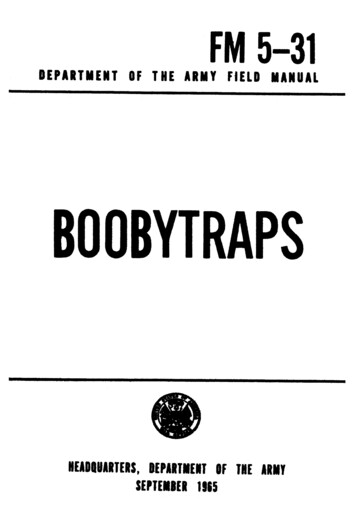
![Last or Business First [Maiden] Page Title Notes](/img/1/saukcity125thjubilee-20historical-20album-index.jpg)

